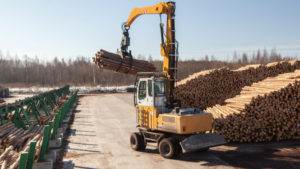
By Den Edryshov @ Shutterstock.com
Bad weather in some key housing markets had tempered demand for lumber, as builders are slowed down. Some big mill owners have even trimmed their output in the face of lower product prices. Ryan Dezember reports for The Wall Street Journal:
Lumber prices typically rise in the spring as builders stock up for construction season. But this year, they are being hit hard by bad weather and a decline in home building.
The slump comes a year after lumber prices reached record levels and were climbing higher amid a resurgent U.S. housing market, a boom in spending on home renovations and difficulties transporting wood from mills to building sites.
Lumber futures settled 2% lower at $334.40 per 1,000 board feet on the Chicago Mercantile Exchange on Wednesday—down nearly half from the high of $639 reached on May 17, 2018. Prices collapsed right after they hit that peak, and there has been little reason this spring for them to bounce back.
Lumber producers are facing reduced residential construction, signs that remodeling work may slow and gains in output and efficiency at mills in the South.
Two big Canadian mill owners— Canfor Corp.and Interfor Corp. —said last week that they would curtail output in their British Columbia facilities in response to low prices. The announcements nudged lumber prices higher, but futures have since given up some of the gains.
Bad weather in key markets has hampered building and renovating new homes and limited orders. Nashville, Tenn.’s hot housing market was doused by more than a foot of rainfall in February. Seattle suffered record snowfall, and it has been extremely soggy in two of the country’s top markets for fix-and-flip jobs, Birmingham, Ala., and Memphis, Tenn.
Read more here.
